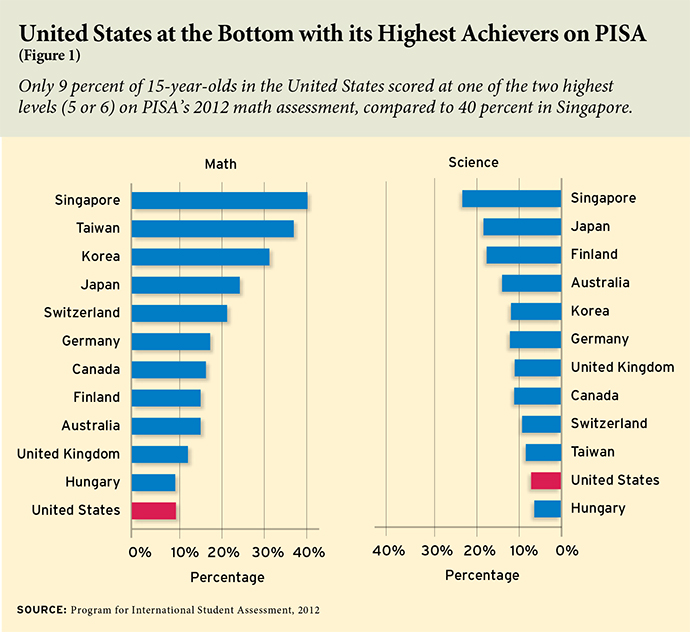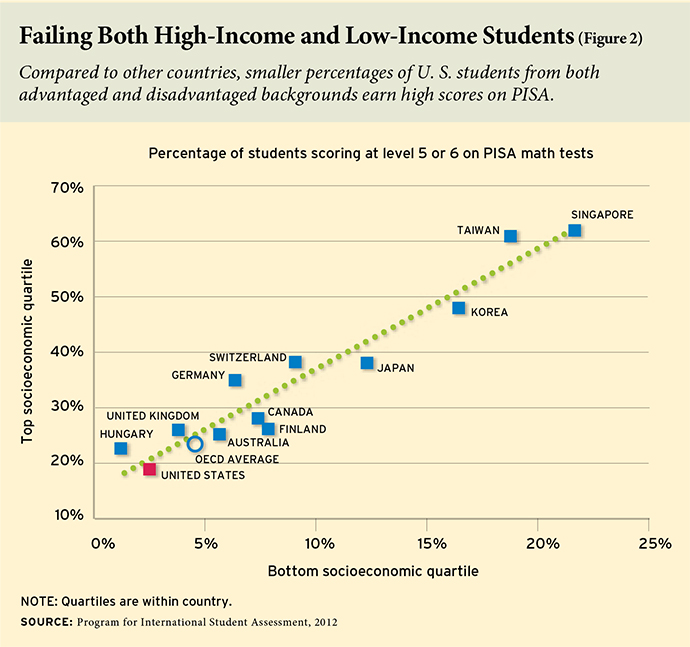Intel’s recent announcement that it will cease sponsoring and underwriting the prestigious Science Talent Search (which it took over from Westinghouse in 1998) is another nail in the coffin of “gifted education” in the United States.
Unlike many European and Asian countries, which are awash in academic competitions, Olympiads, and other status-laden contests that bright students (and their schools and teachers) vie to win, American K‒12 education has relatively few that anyone notices, save for the National Spelling Bee that Scripps has valiantly stuck with since 1941. But spelling bees are for middle schoolers. The big deal for high schoolers, at least those with a bent toward STEM subjects, has long been the Science Talent Search, which President George H. W. Bush called the “Super Bowl of science.”
Intel’s turnabout surprised that firm’s former CEO, Craig Barrett, and disheartened many who care about both STEM education and gifted education. It’s another sign of America’s inattention to high-ability learners, especially those from disadvantaged circumstances. That neglect is what triggered our new book, Failing Our Brightest Kids: The Global Challenge of Educating High-Ability Students. All sorts of data—from the National Assessment of Educational Progress, from research studies including the 2011 Fordham Institute report, “Do High Flyers Maintain Their Altitude? Performance Trends of Top Students” by Robert Theaker and his colleagues, and elsewhere—have shown that high achievers made lesser gains in the No Child Left Behind (NCLB) era than did low achievers. Policy efforts that raised the floor and eased the achievement gap did so at the expense of strong students, who were already nudging the ceiling. Under NCLB, schools and teachers had scant incentive to work hard with kids who were already “proficient.” And so they didn’t, especially in places full of poor and minority kids, so many of whom needed extra help to become proficient.
At the same time, data from international measures such as the Program for International Student Assessment (PISA) and the Trends in International Mathematics and Science Study (TIMSS) make painfully clear that the U.S. isn’t propelling nearly as many of its young people into the ranks of high scorers as are competitor nations—not just the “Asian tigers” but also a number of European countries. Canada, too (see Figure 1). Although we fare better in the early grades, by the time kids are 15 (when PISA tests them), our high-end results are anything but high.
America does an especially bad job of getting poor kids into the high-scoring ranks. The Organisation for Economic Co-operation and Development reports PISA results by socioeconomic quartiles (linked to parent occupation and education, family wealth, home educational resources, and more). This “ESCS” index is controversial, yet the data shown in Figure 2 are instructive—and depressing. Of the 12 countries we studied, the U.S surpasses only Hungary in getting lowest-quartile youngsters into the top-scoring ranks. Less than 3 percent of American students in the bottom ESCS quartile reach PISA’s top tiers in math, yet 21 percent of disadvantaged Singaporeans achieve this. And when we compare these kids to those from the top quartile, we see that a high-ESCS test-taker in the U.S. is eight times likelier than a low-ESCS student to be a top scorer in math. In Canada that ratio is four to one, in Korea and Finland three to one. (Comparisons based on parents’ education show very similar gaps.)
Poor kids can do so much better than most of them are doing in the U.S. today. Consider the recently publicized example of Abdisamad Adan, a Harvard freshman from Somaliland, about as poor a place as can be found on the globe. Abdisamad grew up with 18 brothers and sisters in a small home without electricity. He caught a break when Jonathan Starr, an American and former hedge fund manager, started the Abaarso School of Science and Technology, a boarding school in Somaliland meant to serve the country’s brightest boys and girls. Abdisamad thrived there, which gained him admission to a college prep school in New York—and then, impressively, to Harvard. Talk about upward mobility—the result of ability plus a great school designed to develop the ambitions and intellects of such youngsters.
Then there’s Lin-Manuel Miranda, who wrote the book, music, and lyrics for Hamilton, the Broadway smash in which he also stars. The other day he won one of this year’s 24 MacArthur Foundation “genius” awards. When Miranda’s father moved to New York as a young man, he spoke no English—but when Miranda was six, he was accepted into Hunter College Elementary School, a public school for intellectually gifted children that seeks to identify able kids from all parts of town. His first theatrical successes occurred within the Hunter College system, which cultivated his genius and created his opportunity.
Looking beyond U.S. borders, most of Failing Our Brightest Kids reports what we learned about how 11 other nations educate gifted students, based on conventional research, site visits, on-the-ground correspondents, pummeling the data, and taking advantage of expert pummeling by others (especially Eric Hanushek, Paul Peterson, and Ludger Woessman). Here’s some of what we found:
• Although countries with strong overall achievement also tend to have many top scorers, the U.S. cannot assume that raising the water level will do enough for the gifted-ed boat, as it’s far too small to contain all who belong in it.
• Culture matters. When parents value education and push their kids, it makes a difference. Where competition is appreciated rather than shunned, more kids push themselves. (That’s what’s been so great—and rare—about the Science Talent Search.)
• Policy matters, too. No Child Left Behind makes it essentially impossible for states to test kids on “out of grade level” material, a policy intended to prevent the tests from being “dumbed down” for low achievers. Well meaning, sure, but this policy also makes it impossible for states to truly track academic gains by high achievers. A provision in the Senate-passed reauthorization would solve this problem—at least would void the current ban—but this is not yet law.
• Waiting for high school to beef up the offerings for high-ability youngsters is a mistake, particularly for smart kids from disadvantaged circumstances who depend on the school system from day one to help them realize their potential.
• “Differentiated instruction” sounds great, but in the end is no substitute for separate learning opportunities, supplements, acceleration, and enrichment programs. Rare is the teacher who can do right by her ablest pupils at the same time she provides slower learners in her classroom the attention that they need.
After digesting what we learned, we stand by a number of recommendations for how the U.S. could do a better job:
Arguably most important, let’s get this topic back onto the policy agenda and rekindle the debate about a society that prizes excellence as well as equity and that can deal with both at the same time, much as it deals with “pluribus” and “unum” simultaneously.
We should conduct universal ability screening. Almost every U.S. public-school student now takes state exams in (at least) reading and math from 3rd grade on. Let’s identify, say, the 5 percent with the highest scores in a school, district, or state in 3rd or 4th grade, much as Singapore and Western Australia do. Instead of using IQ or aptitude tests like they do, however, we should use existing—and universal—achievement metrics. Then we can supplement their ranks with kids whose promise is spotted by their teachers.
Student progress should be based on mastery. The single best thing our education system could do for high-ability students (and everybody else) is to enable them to move through the curriculum at their own pace. Instead of age-based grade levels—placing all 11-year-olds in 5th grade and holding them to the same performance standards—let students proceed on the basis of mastery, one unit or module at a time, subject by subject, with no obligation to all move at the same rate.
Besides allowing for acceleration, schools and districts should encourage flexible ability grouping within classrooms, multiage and multigrade groupings, the use of technology for “blended learning,” and whatever else they can to facilitate the educational individualization that we already demand for disabled youngsters and in time should provide to everyone.
We should not be afraid of separate classrooms, afterschool and summer programs, and even separate schools for high achievers. Places like the Bronx High School of Science and the Thomas Jefferson High School for Science and Technology, in Alexandria, Virginia, are educational treasures. But we don’t have enough of them—and we almost never provide their equivalent for elementary- and middle-school students, which would do much to launch more high-ability poor kids on a trajectory to success.
It’s unfashionable, even politically incorrect, to push for better education for smart kids. One can easily be labeled elitist and swiftly admonished that attention and resources should focus laser-like on the “truly needy.” But plenty of smart kids are needy, too, especially those without middle-class families and suburban guidance counselors to help them navigate the turbid waters of American K‒12 education. And the country is also truly needy. It’s in need of more top-flight scientists, inventors, and entrepreneurs to ensure its future security, prosperity, and competitiveness—which is exactly why Intel’s suspension of its Science Talent Search sponsorship is so shameful.
Former University of Michigan president Mary Sue Coleman was a finalist in that competition in 1961. “It was the Sputnik generation, when America was competing with Russia to get into space,” she recently told the International Business Times. “It was a national obsession. People in school cheered us on like we were star athletes. I got letters from the heads of corporations.”
Shame on Intel for pulling the plug and thereby making matters worse. But shame on all of us for neglecting millions of young people who deserve better—and who have the potential to do great things for the United States as well as for themselves.
Chester E. Finn, Jr. is distinguished senior fellow and president emeritus at the Thomas B. Fordham Institute, where Brandon L. Wright is managing editor and policy associate.




